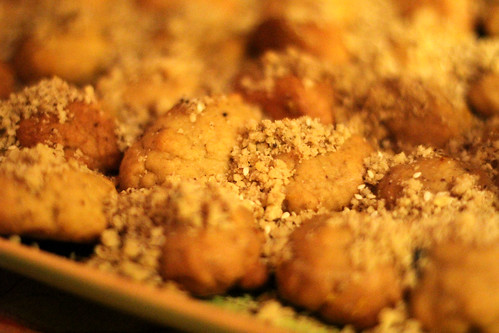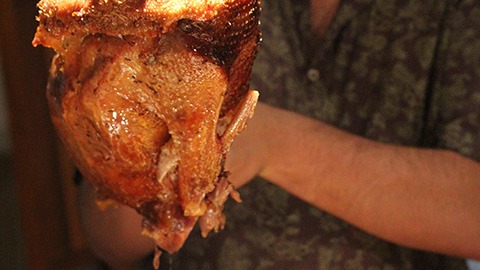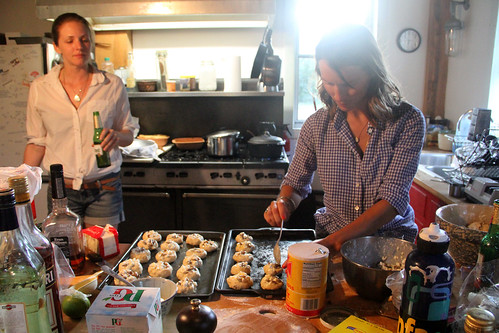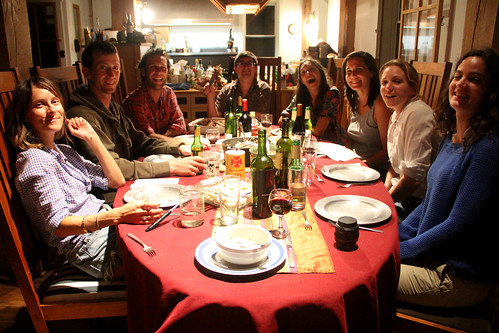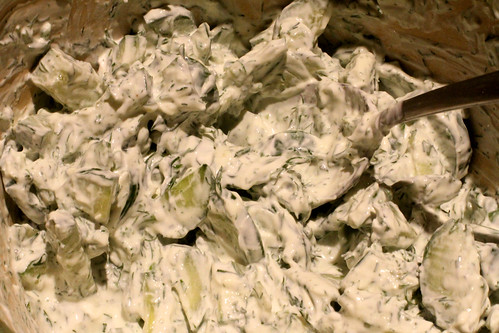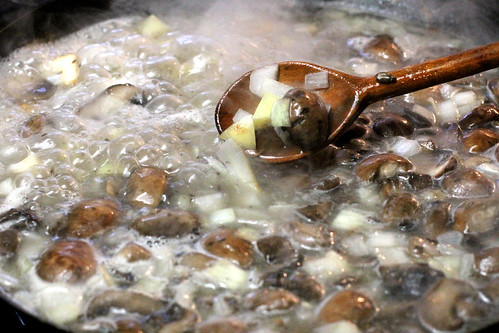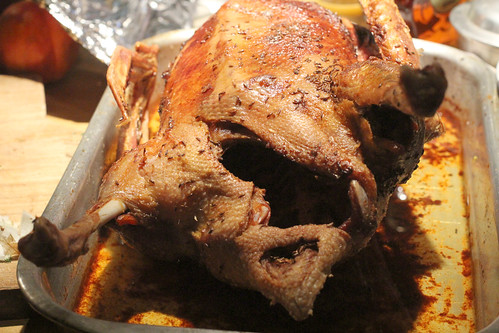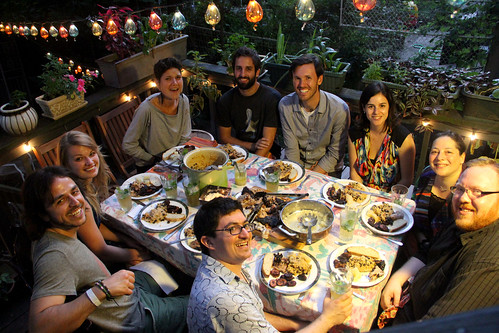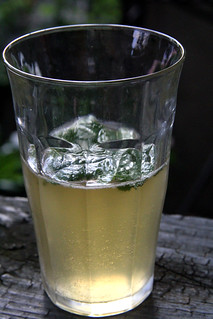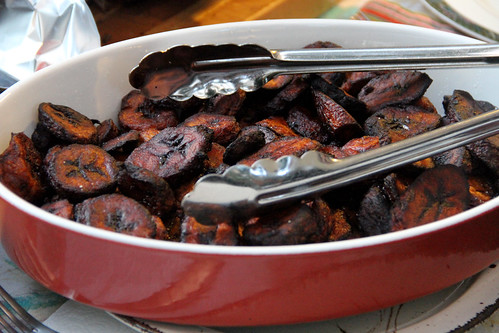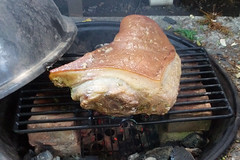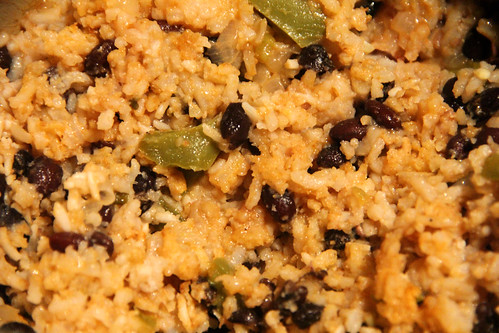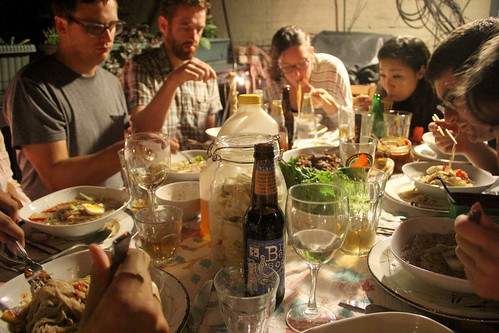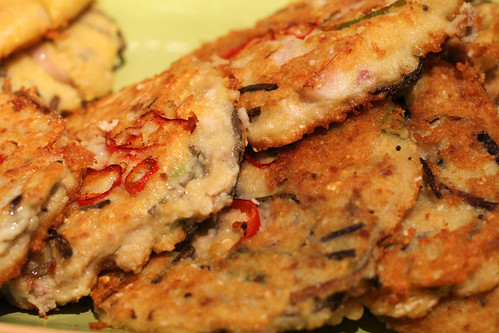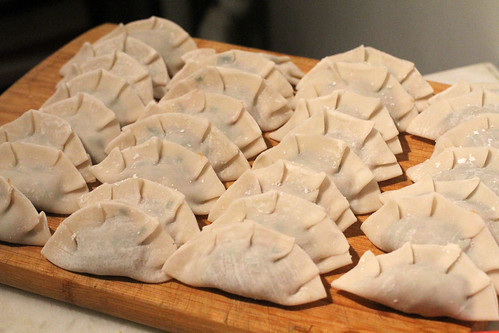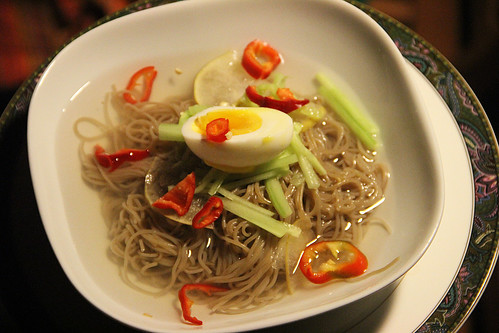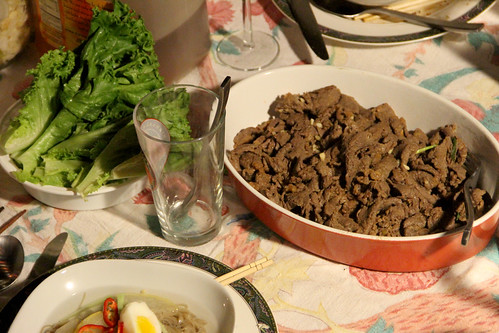What a special night! 75 guests, most of whom had never been to a Nosh before, gathered in the beautiful ballroom at Hostelling International on the Upper West Side, for a meal of classic Congolese dishes.

The idea came from Ari, the community engagement manager at the hostel, who saw our email on The Listserve and reached out to see if we might want to do a Nosh with them. With a big venue and kitchen, we decided to align it with World Food Day and make it a big fundraising opportunity...and at the end of the evening, that made for $1,400, or 5,600 meals to people in need! According to the WFP, the Democratic Republic of the Congo — the former Zaire — ranks lowest in the world for human development and hunger, and 70% have inadequate food. Needless to say, a rich and tasty meal like ours, with plenty of meats, vegetables, and oil, is far beyond the reach of most Congolese.

It turns out it would have been hard to find a more convenient neighborhood for cooking the meal. Less than a mile away is a wonderful little African market that had the palmnut sauce, cassava powder, and other specialty goods I needed, sold by a very friendly and enthusiastic proprietor. The manager at the nearby Gristedes let me borrow a shopping cart to haul back all the meat, and the cart proved very handy for hauling back a huge load of greens, plantains, and other produce.

There's no way we could have done this meal without the help of our many volunteers, who helped set up, cook, and clean up. The huge kitchen area comprising four ranges, two sinks, and dozens of pots and frying pans was buzzing with chopping, frying, stirring, and only one having to find the maintenance staff to crank up the ventilation hoods. Huge thanks to everyone who pitched in! And we owe an enormous debt of gratitude to Ari and the rest of the staff at the hostel who were incredibly friendly and accommodating.

Arachides rôties | Roasted peanuts
These freshly shelled peanuts came in little hand-tied baggies, a dollar a piece. So simple to throw them in a hot, dry frying pan, shake 'em around for a few minutes until they start to darken, then toss in a bowl with a little salt. Great as a snack or a topping.
Poulet mwamba | Chicken in palmnut sauce | Recipe

Not only did we cook forty pounds of dark-meat chicken, but to get it to cook faster (and to follow the recipe), we had to cut it into bite-sized pieces. Turns out I learned the hard, and potentially stupid, way that a glass cutting board isn't meant for cleaver-whacking:

Fifteen minutes later and Laura was back with a cutting board, I kept whacking away at chicken limbs, and Jason set to work browning the hundreds of chunks in five frying pans of red palm oil across two stovetops, his camera slung across his shoulder like a bandolier.

Ari, our incredibly gracious host at Hostelling International, smiled wistfully as he entered the kitchen. "It's so comforting that you're making the hostel smell like palm oil!" Once you know that rich smell, something kind of at the intersection of thick lotion, paprika and mineral oil but in a good way, it's hard to forget. Turns out, we used not just the oil, but also the thick pulp rendered from crushing palm nuts. Thinned a bit with some water, and livened up with salt and chilies plus onions and garlic sauteed in the pans after browning the chicken, it all cooked up into two big pots worth of thick and very rich stew, a very stick-to-your-ribs endeavor. We also made a vegetarian version, with eggplant and zucchini and an extra dose of onions, which was arguably tastier than the chicken version.
Boeuf sauce arachide | Beef in peanut sauce | Recipe

"Goober," the folksy nickname for the peanut, comes from the Kikongo name for the groundnut, nguba. You can make a tasty peanut sauce with just about any meat, and in fact I'd intended to make it with goat but I couldn't find that in my short shopping time, so beef it was. As you can see, the list of ingredients is very simple, but the result is really satisfying and complete. I picked up some surprisingly flavorful chili powder from Mali, maybe that did the trick. Whatever the reason, there was certainly none left!
Bitekuteku | Callaloo greens | Recipe

I did a whole lot of research around this one. I wasn't relishing making yet another dish from frozen cassava greens, so I was happy to see this dish for a different type of green. But I wasn't confident I'd be able to find it fresh. I was all prepared to substitute collards or chard, but lo and behold, the produce shop across the corner from the hostel had it! It's yet another of those foods that crossed the Atlantic in the slave trade, and somehow it ended up with the name "callaloo." Anyway, I cleared them out of all 16 bunches.
Who knew how much labor callaloo requires? The stems are pretty tough, but the leaves are haphazardly arranged, so removing them takes a whole lot of labor, for which Alex and her support crew deserve particular praise. Then you have to blanch them in boiling water with baking soda, and even with two pots going at a time, that took a while. We got a head start on the timing by sauteeing the green onions and eggplant ahead of time and dropping in the greens. Happily, it was really tasty, and the big crowd made fast work of it.

Fufu | "Stiff porridge"
Practice is starting to make perfect! I'm finally starting to get the hang of it, I think. This time we used a blend of corn and cassava flours, used the big-ass paddle I bought a few months ago, and I recruited Sarah's strong arms and energy to mix it up. She stirred a small amount into the big pot of just-boiled water, then added more of alternating flours until it got kinda thick, then stirring like mad until it got really thick. (Jessica also helpfully suggested that one person hold the pot steady while another grips the paddle with both hands and uses upward motion against the side of the pot to smooth out lumps.) The fufu turned out thick enough to grab with your hands, and tasted like mostly nothing...so, success! Also, it just ran out at the end of the evening, so maybe it's dumb luck but I'm glad we made the right amount.
Pili pili | Hot sauce | Recipe
This one's even simpler than the hot sauce for Comoros. Seeded hot peppers, onion, garlic, and a bit of oil. Simmer for an hour. Done. Quite spicy, richly flavorful, crowd pleaser. I thought I was being responsible by washing my hands like 20 times after cutting all the scotch bonnets, and I'm glad I did. However, I only gave the pot a standard cleaning — and the next morning's oatmeal turned out spicy! Lesson learned. Wash everything a lot after making hot sauce.
Bananes plantains au four | Baked plantains

Fried plantains are always the tastiest. But it takes a lot of work and time and makes a royal mess, as we discovered for the Cameroonean meal. So, we got most of the fun for about 10% of the work by simply peeling the plantains, slicing them in half, and baking the off for a half hour. Thanks to the abundantly equipped kitchen, we had six trays going across three ovens! And every last plantain was gobbled up.
What made us perhaps the happiest from this meal, even beyond the beautiful space and the people who went back for thirds and the money raised, was that most people stayed far longer than they had to, making new friends around the dinner table. Having made it just about a quarter of the way through the nations of the world, it's the joy of combining adventure and community that has become so motivating!
Stay tuned for our post from Denmark!
Photos by Jason Falchook, Chrys Wu, and Laura Hadden.



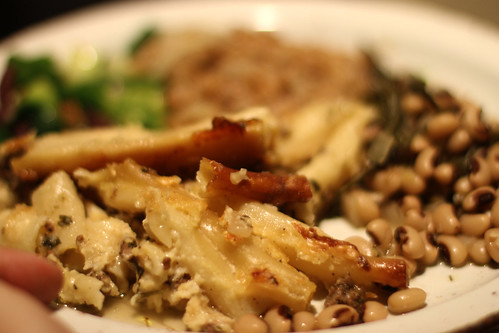
 Joining us for this pleasant, post-mosquito night on the back porch, in addition to Iva, were Rachel (who's got a great project going with
Joining us for this pleasant, post-mosquito night on the back porch, in addition to Iva, were Rachel (who's got a great project going with 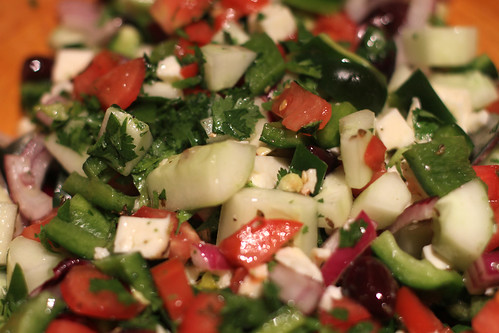 If you've ever had a Greek salad, this is a pretty similar beast, with tomatoes, cucumbers, green peppers, olives and oregano. What makes this Cypriot is the halloumi cheese, which is moister and firmer, and a bit less salty, than feta. Also the dressing is based on lemon juice rather than the vinegar you sometimes see.
If you've ever had a Greek salad, this is a pretty similar beast, with tomatoes, cucumbers, green peppers, olives and oregano. What makes this Cypriot is the halloumi cheese, which is moister and firmer, and a bit less salty, than feta. Also the dressing is based on lemon juice rather than the vinegar you sometimes see.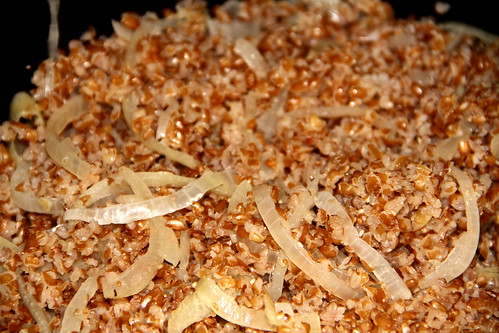 I think I see a bit of Middle East influence in bulgur, or cracked wheat, in this dish! Though the flavor was simple, it was definitely enlivened by some thick yogurt.
I think I see a bit of Middle East influence in bulgur, or cracked wheat, in this dish! Though the flavor was simple, it was definitely enlivened by some thick yogurt. I'd be surprised if it wasn't the Venetians who introduced the pasta used in this casserole which is well known as a Greek dish but which Iva claims is originally from Cyprus. It was certainly tasty, but what was supposed to be a thick and fluffy bechamel of flour, milk and butter was quite runny and kind of drooped down like a cobbler rather than floating on top like a meringue. I think it was my fault for adding the second half of the milk too quickly rather than slowly incorporating it patiently into the pan of milk and flour. Be that as it may this was still plenty yummy.
I'd be surprised if it wasn't the Venetians who introduced the pasta used in this casserole which is well known as a Greek dish but which Iva claims is originally from Cyprus. It was certainly tasty, but what was supposed to be a thick and fluffy bechamel of flour, milk and butter was quite runny and kind of drooped down like a cobbler rather than floating on top like a meringue. I think it was my fault for adding the second half of the milk too quickly rather than slowly incorporating it patiently into the pan of milk and flour. Be that as it may this was still plenty yummy.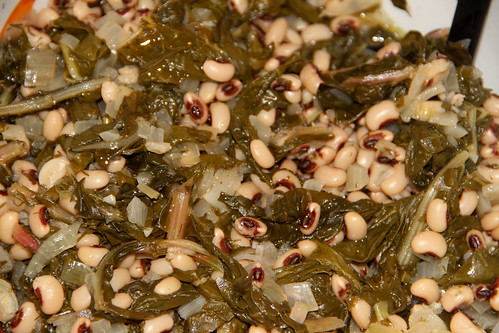 A beautifully rustic combination of legumes and greens. Interestingly, dried black eyed peas cook much more quickly than normal beans, which is good to know if you have limited time. The dish overall was nice and a bit tangy with the lemon, but honestly the leftovers were bolder and in my opinion better when I added red wine, sumac, roasted garlic, Aleppo pepper and more lemon juice.
A beautifully rustic combination of legumes and greens. Interestingly, dried black eyed peas cook much more quickly than normal beans, which is good to know if you have limited time. The dish overall was nice and a bit tangy with the lemon, but honestly the leftovers were bolder and in my opinion better when I added red wine, sumac, roasted garlic, Aleppo pepper and more lemon juice.